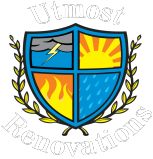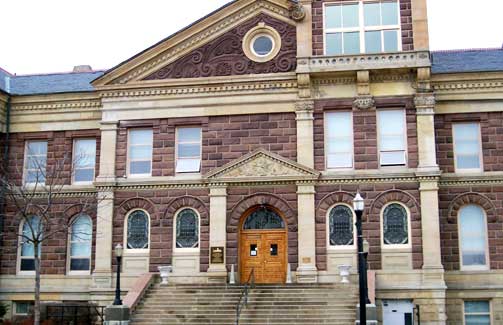Winston Churchill said, “We shape our buildings; there after our buildings shape us”. Each building and structure tells an individual story of the past, present, and future. Each building is different and choosing the correct individual to restore a building can be a daunting task. A good contractor is essential for proper maintenance, restoration, and preservation of architecture – Historic Masonry Preservation. Each building has particular needs in regards to masonry. Nearly all buildings are made with masonry-brick, stone, terra cotta, and/or concrete block. Considered to be permanent, over time masonry is subject to deterioration, especially at the mortar joints. Repointing or “tuckpointing” is the process of removing failed mortar from the joints of a wall and replacing it with new mortar. Properly done, tuckpointing not only restores the unique splendor of the building but also improves the buildings physical integrity. Tuckpointing incorrectly can cause physical destruction to the structure as well as disfigure the beauty of the building. Tuckpointing a historical building or structure with no regard to the architecture and craftsmanship can cause irreversible damage. The person who works on historical buildings must have excellent communication skills and knowledge of architecture to plan and execute a proper restoration that maintains the buildings integrity.
The decision to tuckpoint is most often related to signs of deterioration such as damaged plasterwork, damp walls, loose bricks or stones, cracks in mortar joints, and disintegrating mortar. It is erroneous to assume tuckpointing alone will solve all deficiencies from other problems. Often the root cause of deterioration can be caused by leaking roofs or gutters, settlement of the building, or extreme weather exposure. Because there are so many possible causes for deterioration the difference between using a good and a great contractor specializing in Historic Masonry Preservation can save time and money in the long run. Sometimes, the solution to a problem with a structure is simple and if caught early can be easy and inexpensive to remedy. Often inexperienced masons will inaccurately tuckpoint an entire building without solving the issues and/or leaks that were there to begin with. Unfortunately, good contractors often see scenarios in which the client or building owner overpay for services they don’t need. A great contractor will work at finding the accurate cause of deterioration as well as offer cost effective solutions. If tuckpointing is deemed necessary it is important the general contractor have extensive knowledge in historical background of architecture as well as mortar kinds and types. There are many different types of materials used for buildings. For thousands of years mortar consisting primarily of lime and sand had been used as an integral part of masonry structures and buildings. Until the mid-nineteenth century lime or quicklime was delivered to construction sites to be combined with water or slaked. Once the mixture was combined with water it would boil to make wet putty. The putty was left to mature in a pit or wooden box for several weeks up to a year.
Traditional mortar was made from lime putty or slaked and then combined with sand. Other materials such as crushed marine shells, brick dust, clay, natural cements, pigments, and even hair can be found in mortar. Portland cement was patented and was a fast curing hydraulic cement that was common to use until the 1930’s. Until the turn of the century Portland cement was considered an additive or minor ingredient to help with set time. Mortar found between 1873-1930 can range from pure lime and sand mixes to a wide variety of lime, Portland cement and combinations. Following the 1930’s more mortar products and more possible variations. Simply put there are many different varieties of mortar types and mixes and knowing the historical significance of these is important to maintain the physical structure of the building. Each building as well as mortar and type of mortar present its own set of rules. Mortars for repointing projects, especially those involving historic buildings are custom mixed in order to ensure the proper physical and visual qualities. Thus, no two repointing projects are exactly the same; a true Historic Masonry Preservation Artist understands this.
Preferably, a good contractor will try to repoint only those areas that require work rather than an entire wall, as is often specified. But if 25-50 percent of the wall needs tuckpointed, tuckpointing the entire wall may be more cost effective than spot tuckpointing. Total tuckpointing may also make sense if the access is difficult and/or may require scaffolding. Each project requires judgement based on a variety of factors and changes from structure to structure. When scheduling, seasonal aspects need to be considered. Curing mortar requires temperatures remain between the 40-95 degree range to prevent freezing or excessive evaporation of water in the mortar. There is much debate of proper mortar analysis, mortar makeup, and even the process of tuckpointing. It is important to use someone with extensive knowledge of various types of masonry and a minimum of five years expertise. Ultimately, according to the The National Parks Service Department of Interior briefs if the exact physical and chemical properties of historic mortar are not of a major significance as long as the new mortar conforms to the following criteria.
-
The new mortar must match the historic mortar in color, texture and tooling. (If a laboratory analysis is undertaken, it may be possible to match the binder components and their proportions with the historic mortar, if those materials are available.)
-
The sand must match the sand in the historic mortar. (The color and texture of the new mortar will usually fall into place if the sand is matched successfully.)
-
The new mortar must have greater vapor permeability and be softer (measured in compressive strength) than the masonry units.
The new mortar must be as vapor permeable and as soft or softer (measured in compressive strength) than the historic mortar. (Softness or hardness is not necessarily an indication of permeability; old, hard lime mortars can still retain high permeability.) A common misconception about mortar is that the mortar should be harder than the masonry units. In actuality mortar should be softer than the masonry units because stresses to the building should be relieved by mortar rather than the masonry units. A mortar that is stronger than the masonry units will not give caused stresses to be placed on the masonry units. Permanent damage can result such as cracking and/or spalling which is not repaired easily. While stresses can also break the bond between the mortar and the masonry units, permitting water to penetrate the resulting hairline cracks, this is easier to correct in the joint through tuckpointing than if the break occurs in the masonry units.
The largest component of mortar is sand as it gives mortar its color and texture. Sand is the largest component of mortar and the material that gives mortar its distinctive color, texture and cohesiveness. Sand must be free of impurities, such as salts or clay. The three key characteristics of sand are: particle shape, gradation and void ratios. The gradation of the sand (particle size distribution) plays a very important role in the durability and cohesive properties of a mortar. Mortar must have a certain percentage of large to small particle sizes in order to deliver the optimum performance. Acceptable guidelines on particle size distribution may be found in ASTM C 144 (American Society for Testing and Materials). However, in actuality, since neither historic nor modern sands are always in compliance with ASTM C 144, matching the same particle appearance and gradation usually requires sieving the sand. Water should be potable—clean and free from acids, alkalis, or other dissolved organic materials that is used in mortar. In addition to the color of the sand, the texture of the mortar is of critical importance in duplicating historic mortar. Most mortars dating from the mid-19th century on—with some exceptions—have a fairly homogeneous texture and color.
One of the final steps in repointing requires removal of the mortar to a depth up to one inch. For stone with wide joints, mortar may need to be removed to a depth of several inches. Although some damage may be inevitable, careful joint preparation can help limit damage. The traditional most effective way to remove old mortar is through the use of chisels and mash hammers. Though this method requires the most effort it is the least dangerous for damaging the historical masonry units and produces the best final product. However, the most common method to remove old mortar is with power saws or grinders. The use of power tools by unskilled masons can be disastrous for historic masonry especially for soft brick.The primary role of the contractor is to ensure the life of the building safely. Often restoring older buildings requires a knowledge of historic construction techniques and awareness of special problems often found in older buildings such as foundation issues. Any historical project would be best completed by a contractor with at least five years of experience with historical preservation. Successful tuckpointing depends on the reputation and skill level of the people completing the job. It may be very tempting to use someone simply because their bid is cheaper. A good repointing job is meant to last at least thirty years, and preferably 50-100 years. Shortcuts and poor craftsmanship can result in diminishing the historic character of the building but as well could require future tuckpointing sooner than if the work had been done correctly. Good tuckpointing practices guarantee the long life of the mortar joint, wall, and historic structure. It is important to remember that joints are made to be sacrificial and over time will probably require more pointing sometime in the future. Just remember, “The sweetness of low price is soon forgotten while the bitterness of poor quality long remains”—Ben Franklin.
If you are planning a historical preservation or masonry restoration building project Utmost Renovations ought to be on your short list of highly qualified expert contractors in the Central Ohio area. They are very knowledgeable and their level of quality and service is first-rate. Utmost is arguably the most viable option in the local marketplace with hundreds of successful historical preservation projects under its belt. They specialize in protecting and restoring property with quality and integrity.
Mark Huffer, is President of Utmost Consulting and Utmost Renovations. He is a BOMA (Building Owners and Managers Association) Instructor on building envelopes and is a leading authority on Building Restoration and Historic Preservation.
Publishing Rights: You may republish this article in your website, newsletter, or book, on the condition that you agree to leave the article, author’s signature, and all links completely intact.




